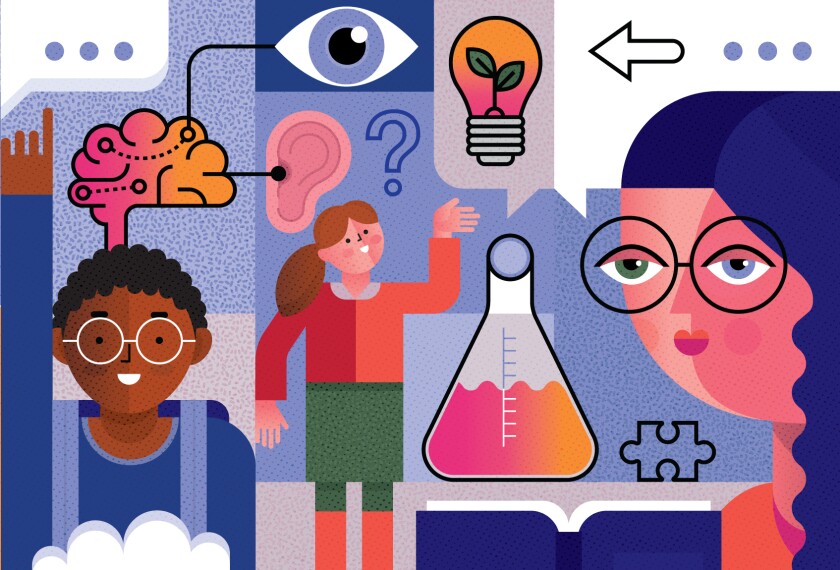Access to computer science courses in high schools has jumped significantly over the past three years—from 35 percent to 51 percent, concludes a new study by the nonprofit Code.org.
But access to those courses still remains uneven in many places. Rural and urban schools, and schools that serve a high percentage of kids from low-income families are less likely to offer foundational computer science.
“We’re thrilled to see that just over half” of schools offer computer science classes, said Katie Hendrickson, president of the Code.org advocacy coalition and director of state government affairs. The nonprofit champions access to computer science. “But then at the same time, we can also look at it the other way and think, well, that’s only half. There’s still half of schools that don’t offer it.”
Black, Latino, and Native American students are more likely to attend a school that doesn’t offer foundational computer science. For instance, 73 percent of Black students nationally and 76 percent of Latino kids go to a school that offers foundational computer science, compared with 79 percent of White students and 89 percent of Asian students.
Overall, the proportion of Black and Native American students in computer science classes is close to the percentage of those groups in the overall public high school population in the 35 states included in the report. For instance, about 15 percent of public high-schoolers in the 35 states that provided data to Code.org are Black, while 16 percent of the kids in foundational computer science courses are Black. Native American and Native Alaskan kids make up about 1 percent of the public high school population in the studied states, and 1.2 percent of those in computer science classes.
There’s an imbalance, though, between the percentage of Latino students in high school and the percentage of Latino students in foundational computer science courses. Latinos make up 26 percent of the public high school population in the states in the study, but just 19 percent of high schoolers enrolled in foundational computer sciences classes. In fact, Latino students are 1.4 times less likely than their White and Asian peers to enroll in foundational computer science, even if they attend a school that offers the subject, the report notes.
Students from economically disadvantaged households make up 52 percent of kids in K-12 schools, but just 38 percent of high school students enrolled in foundational computer science in 34 states that provided data on low-income students taking the subject.
English-language learners comprise 10 percent of the K-12 population, but just 6 percent of high schoolers taking computer science classes in 33 states that provided data on that population to Code.org. And students eligible for special education services under the Individuals with Disabilities Education Act make up 14 percent of all K-12 students but only 9 percent are taking foundational computer sciences courses in 31 states able to provide that information to Code.org.
Those gaps are beginning to close, said Hendrickson, but it’s imperative that states and schools continue to push for greater equity in computer science access.
“We believe that every student should have the opportunity to learn whatever they want and to go into whatever field they choose,” Hendrickson said. “It’s really the American dream, right? We need to give those students that opportunity with computer science.”
She added that computer science jobs are among the best-paying, and, increasingly, can be done from anywhere in the country, as tech companies expand remote working opportunities.
Why state policies matter in improving access to courses
However, there are still major gaps among states in the percentage of schools that provide foundational computer science. In at least three states—Arkansas, Maryland, and South Carolina—90 percent or more of high-schools offer the instruction. But in Kansas and Louisiana, fewer than one-third of high schools offer the classes.
The three top states have all adopted at least seven of Code.org’s nine policy recommendations for improving access to computer science classes. Those policies include steps like establishing rigorous computer science standards, allocating funding for computer science teacher professional learning, and requiring that all high schools offer computer science.
The access data in those states offers clear evidence that “policy really matters,” Hendrickson said. “State leadership and state investments in computer science are really what matter in getting computer science across the board and ensuring that every student has access.”
Skeptics about the importance of integrating computer science education heavily into K-12 learning often argue that other subjects should be given higher priority. They point out that coding skills, for instance, may become much less valued in the workplace as those skills are replaced by machines.
But Hendrickson sees it differently. The way, “computer science is taught in K-12 is more about just understanding how to think logically and sequentially,” she said. “We don’t want to box our students into having to learn very specific programming languages that might not be relevant in a couple of years.”
Instead, courses should focus on, “how to think through problems like a computer,” which can help build critical thinking and other skills, she said.





